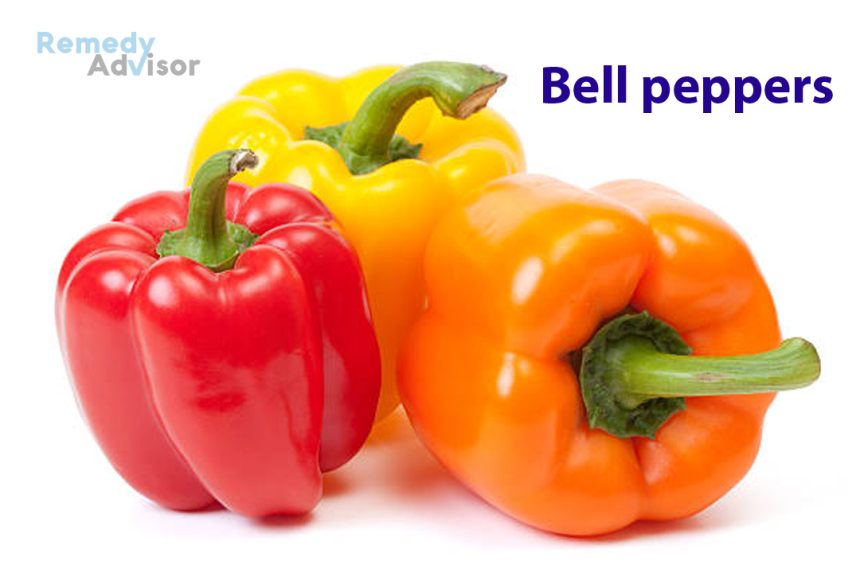Bell peppers, which are also known as sweet peppers, originated in South America; wild varieties have been dated to 5000 BCE. Thousands of years later, Spanish and Portuguese explorers carried bell peppers to other parts of the world. Today, they are grown in many countries. However, the primary commercial producers are China, Turkey, Spain, Romania, Nigeria, and Mexico.
Bell peppers contain an extraordinary amount of vitamins and nutrients. They have excellent amounts of vitamins A, B6, and C and very good amounts of dietary fiber, molybdenum, vitamin K, foliate, and manganese. Bell peppers have good quantities of potassium, tryptophan, copper, and vitamins Bi and E. In addition, they contain beta-carotene, a type of carotenoid (highly pigmented fat-soluble compounds naturally present in many foods). Red peppers are particularly nutritious. They have the phytonutrients lycopene, lutein, and zeaxanthin as well as beta-cryptoxanthin, an orange-red carotenoid? But, what have researchers learned?
Cancer
Colorectal Cancer
In a study published in 2007 in The Journal of Nutrition Japanese researchers investigated the association between the intake of foliate, vitamins and Bi2, and methionine (a sulfur-containing essential amino acid), and the risk of colorectal cancer in a group of middle-aged men and women. The cohort consisted of 81,184 subjects (38,107 men and 43,077 women) who participated in the Japan Public Health Center Prospective Study from 1995-1998. By the end of 2002, there were 526 (335 men, 191 women) diagnosed cases of colorectal cancer. Only vitamin B6, which is found in abundance in bell peppers, gave a statistically significant benefit to the male subjects. When compared to the men consuming the least amount of vitamin B6, the men consuming the most vitamin B6 had a 31 percent reduction in risk for colorectal cancer. The men with higher intakes of alcohol appeared to derive the most benefits. No such results were observed in the women.
The next year, in 2008, Cancer Epidemiology Biomarkers & Prevention published a study on the association between intake of dietary and supplemental vitamin B6 and colorectal cancer. This Scottish study included 2,028 hospital based people with colorectal cancer and 2,722 population-based controls. The researchers noted, “Moderately strong inverse and dose-dependent relations in the complete sample were found among CRC [colorectal cancer] and the consumption of dietary and whole vitamin B6.” The researchers also conducted a meta-analysis of published studies on the topic. They found that higher intakes of vitamin B6 reduced the risk of colorectal cancer by 19 percent.”
Lung Cancer
In a study published in 2003 in Cancer Epidemiology Biomarkers & Prevention, Chinese researchers examined the association between consumption of foods with high amounts of beta-cryptotoxanthin, such as red bell peppers, and lung cancer. Between April 1993 and December 1998, the data were collected from 63,257 men and women between the ages of 45 and 74 who lived in Shanghai, China. During the first eight years of follow-up, medical providers diagnosed 482 cases of lung cancer. The researchers found that when compared to the men and women who ate the least amount of beta-cryptotoxanthin, the men and women who ate the highest amounts had a 27 percent lower risk for developing lung cancer. Even smokers received protection from consumption of foods with beta-cryptotoxanthin. When compared to smokers who ate the least amount of beta-cryptotoxanthin-rich foods, smokers who ate foods with high amounts had a 37 percent lower risk of lung cancer. The researchers wrote that their findings, “lend additional credence to prior experimental and epidemiological data in support of the hypothesis that dietary B’Cryptoxanthin is a chemo-preventive agent for lung cancer in humans.”
Cardiovascular health

In a study published in 2009 in Circulation, Boston researchers reviewed the relationship between fasting plasma levels of vitamin B5 and the rates of heart attacks (myocardial infarctions) in women. The study included 144 women who participated in the ongoing Nurses’ Health Study and experienced a heart attack. Each woman was matched to two other Nurses’ Health Study women for age, smoking status, and other factors-but without a history of heart attacks. The researchers found a significant association between plasma levels of B6 and heart attacks. When compared to the women in the lowest quartile of plasma B6, the women in the highest quartile of B6 had a 78 percent lower adjusted risk of a heart attack. When the data were analyzed according to age, the women 60 years of age and older who were in the highest quartile of plasma B6 had a 64 percent lower risk than those in the lowest quartile. The women under 60 who were in the top quartile of plasma B6 had a 95 percent lower risk of a heart attack.
Osteoarthritis of the knee
In a study published in 2007 in Arthritis Research & Therapy, Australian researchers examined the association between intake of vitamin C and osteoarthritis of the knee. (As has been noted, bell peppers have excellent amounts of vitamin C.) The researchers selected 293 healthy adults, with a mean age of 59.0 years, who are free of knee pain. After 10 years, the knees of these subjects were examined by magnetic resonance imaging (MRI studies). The researchers found that the subjects who ate high amounts of vitamin C were less likely to have the bone degeneration that leads to knee osteoarthritis. The researchers wrote that, “The present study suggests a beneficial effect of vitamin C consumption on the decrease in bone size and the number of bone marrow scratches, both are significant in the pathogenesis of knee OA [osteoarthritis].” Furthermore, the researchers learned that additional antioxidants, like zeaxanthin and lutein, which are found in bell peppers, are protective against the normal age-related wear and tear on the knees.
On the other hand, a study published in 2004 in Arthritis & Rheumatism determined that too much vitamin C might exacerbate osteoarthritis of the knee. Researchers from Duke University Medical Center led an investigation into the effects of eight months of treatment with low, medium, and high doses of vitamin C in guinea pigs. (Like humans, guinea pigs are unable to synthesize vitamin C.) The researchers determined that the guinea pigs in the high-dose group suffered the most severe osteoarthritis of the knee and worst cartilage damage.
Cataracts
In a study published in 2008 in the Archives of Ophthalmology, Boston researchers examined the association between intake of the carotenoids lutein and zeaxanthin, found in bell peppers, and the risk of cataracts. The researchers followed 35,551 women for an average of ten years. During that time, there were 2,031 confirmed cases of cataracts. The researchers found that the women with the highest intake of lutein and zeaxanthin (6,716 micrograms per day) had an 18 percent lower risk of developing cataracts than the women with the lowest average intake (1,177 micrograms per day). The researchers commented that their findings showed, “higher dietary intakes of lutein/zeaxzanthin from food and supplements were associated with significantly decreased risk of cataract.”
Caveats
Roasting bell peppers increases their levels of acidity. That makes them more likely to erode the enamel on teeth. After eating roasted bell peppers, it is best to brush the teeth and/or rinse the mouth with water.
Not all bell peppers have the same antioxidant activity. Red bell peppers have the most. Next are orange bell peppers; followed by yellow. Green peppers are a distant fourth.
Farmers tend to use a good deal of pesticides on conventionally grown bell peppers. It is best to eat peppers that have been grown organically.
Should bell peppers be included in the diet? Certainly. However, as a precaution, people who have diets that are high in vitamin C should eat bell peppers in moderation.







